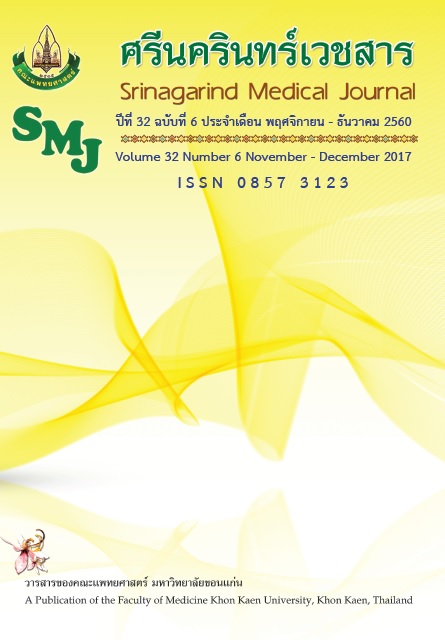Patterns and Successful in Stopping Budesonide Inhaler Use in Asthmatic Patients Aged 1 – 5 years: A Retrospective Study
คำสำคัญ:
childhood asthma; budesonide inhaler; Inhaled corticosteroids; step-down; โรคหืดเด็ก; budesonide inhaler; ยาสูดสเตียรอยด์; การลดขนาดยาสูดสเตียรอยด์บทคัดย่อ
Background and Objectives: Budesonide inhaler (BUD) uses and successful stopping BUD uses in childhood asthmatic patients have been less reported. The objective of this study was to determine pattern of BUD uses and its associations with successful stopping BUD uses in asthmatic patients aged 1-5 years.
Methods: Data of asthmatic patients aged 1-5 years recorded during 2004-2016 were retrospectively collected from electronic database of Warinchamrab hospital. The patterns included dose, quantity and duration of medication uses. A multiple logistic regression was applied to examine associations between the patterns of BUD uses and BUD stopping success.
Results: Of total 648 patients, aged 2.55 ± 1.16 years and most of them were male (59.4%), controlled asthma with BUD dose 800mcg/day (77.9%), used BUD at maximum control dose for >12 month until stepping-down (69.2%) and successful in stopping BUD use (84.0%). After adjusting for patients’ characteristics, duration of continuing asthma control before stepping down for at least 12 months would increase odds of successful stopping BUD use (OR=2.21, 95% CI 1.37-3.55, p=0.001) whereas duration from diagnosis to receiving BUD more than 3 months and stepping down in rainy season (Jul-Oct) would decrease odds of successful stopping BUD use compared with summer season (Mar-Jun) (OR=0.52, 95% CI 0.32-0.86, p=0.011 and OR=0.48, 95%CI 0.28-0.84, p=0.011, respectively).
Conclusion: The findings of this study indicate that early start of BUD use after diagnosis and longer duration of asthma control with BUD increase successful stopping BUD with no exacerbation.
หลักการและวัตถุประสงค์: การรักษาโรคหืดด้วยยาbudesonide inhaler (BUD) และการหยุดยาสำเร็จในผู้ป่วยโรคหืดเด็กมีรายงานอย่างจำกัดการศึกษานี้มีวัตถุประสงค์เพื่อศึกษารูปแบบการใช้ยา BUD และผลต่อการหยุดยา BUD สำเร็จในผู้ป่วยโรคหืดอายุ 1-5 ปี
วิธีการศึกษา: ทำการศึกษาแบบย้อนหลังจากฐานข้อมูลอิเล็กทรอนิกส์ของโรงพยาบาลวารินชำราบ ในผู้ป่วยโรคหืดอายุ 1-5 ปี ที่ได้รับยาBUD ระหว่างปี พ.ศ. 2547-2559รูปแบบการใช้ยาได้แก่ ขนาด ปริมาณ และระยะเวลาการใช้ยา หาความสัมพันธ์ของรูปแบบการใช้ยากับความสำเร็จในการหยุดยา BUD ด้วย multiple logistic regression
ผลการศึกษา: ในผู้ป่วยทั้งหมด 648 ราย อายุเฉลี่ย 2.55 ± 1.16 ปี ส่วนใหญ่เป็นเพศชาย (ร้อยละ 59.4) ควบคุมอาการได้ด้วยยาBUD ขนาด 800 mcg/day (ร้อยละ 77.9) ใช้ยาBUD ในขนาดที่ควบคุมอาการได้ต่อเนื่อง >12 เดือนจึงปรับลดยา (ร้อยละ 69.2) และหยุด BUD สำเร็จ (ร้อยละ 84.0) ปัจจัยที่สัมพันธ์กับการหยุดยาสำเร็จ ได้แก่ ระยะเวลาตั้งแต่เริ่มวินิจฉัยจนถึงเริ่มให้ยา BUD ตั้งแต่ 3 เดือนขึ้นไป (OR=0.52, 95% CI 0.32-0.86, p=0.011) กลุ่มที่ได้ยา BUD ขนาดสูงสุดที่ควบคุมอาการได้ก่อนลดขนาดไม่น้อยกว่า 12 เดือน หยุดยาสำเร็จมากกว่ากลุ่มที่ได้ยาน้อยกว่า 12 เดือน (OR=2.21, 95% CI 1.37-3.55, p=0.001) การลดขนาดยาในฤดูฝน (ก.ค.-ต.ค.) หยุดยาสำเร็จน้อยกว่าฤดูร้อน (มี.ค.-มิ.ย.) (OR=0.48, 95% CI 0.28-0.84, p=0.011)
สรุป: จากผลการศึกษานี้ ผู้ป่วยควรได้รับยา BUD หลังวินิจฉัยเร็วที่สุด ร่วมกับให้ยาในขนาดที่ควบคุมอาการได้อย่างน้อย12 เดือนก่อนลดขนาดยา เพื่อเพิ่มผลสำเร็จในการหยุดยา




